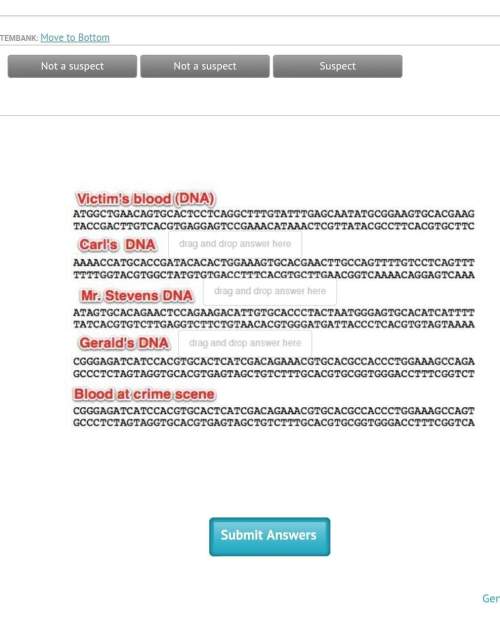
Early one monday morning, as mr. stevens the custodian, walked through the school, he noticed a foot sticking out from under a science lab bench. mr. stevens flipped on the light and saw mel brown laying under the lab table. stevens felt for a pulse. nothing. he noticed blood on mel's head and hands; there were blood spatters on the floor and a larger pool of blood on the floor under mel's head. mr. sevens dialed 911. the police along with their forensics team arrived shortly before school started. they collected the evidence and took the body to the crime lab. using dna evidence forensics determined that there was two blood samples at the crime scene: mel's and an unidentified sample. the police asked mr. stevens for a dna sample and he immediately gave them one. some students had told the police that mel had been arguing the afternoon before with two of his friends: carl smith and gerald jones. mel had apparently done their science lab work and the boys had refused to pay him, as previously decided. the police decided to collect dna samples of carl and gerald as well. the results provided some enlightening evidence: one of the three people tested had been at the crime scene! using str evidence, can you identify the person whose blood was found at the scene?


Answers: 1


Another question on Biology

Biology, 21.06.2019 19:30
What is the "great pacific garbage patch"? a large area of marine debris concentrated by rotating ocean currents a large area around the pacific rim where debris collects from natural disasters such as tsunamis an area in the pacific ocean where trash is intentionally dumped due to lack of landfill availability a large trash dump located in hawaii
Answers: 1

Biology, 21.06.2019 20:30
For your initial isolation of the bacterium, you simply needed to grow enough of it that you could identify some of its more general features. thus, you used a complex nutrient agar that would allow for the growth of almost any bacterial species. different bacterial species often have very specific requirements for life. this is a fact that you can utilize when you are trying to identify the bacterium to the species level. growth conditions that will permit the growth of one species but not another may allow you to select which one you would like to culture. you can utilize different selective/differential media that allow for the growth of only one type of bacteria (e.g., either gram positive or gram negative). culturing media such as phenylethyl alcohol or sodium chloride agar will be selective/differential for gram-positive bacteria. you may also want to show that it is different from other bacteria that may be present, so you could use a selective/differential agar. selective/differential media such as blood agar or phenol red sugar broths allow for the determination of whether a bacterial cell can grow and utilize specific ingredients included in the medium and turn the agar a distinct color. sheep's blood agar utilizes red blood cells to differentiate which bacterial species may have hemolytic properties.selective or differential? 1. an agar that uses a high salt concentration to limit the growth of one type of bacteria over another would be considered selective/differential. 2. if an agar contains a dye or ph indicator in the presence of a sugar, it is generally considered selective/differential for those bacteria that may ferment the sugar over those that cannot. 3. an agar that uses the dye in crystal violet agar suppresses the growth of gram-positive bacteria. this agar would be considered selective/differential. 4. the selective/differential aspect of macconkey agar allows for the determination of which bacteria are lactose fermenters and which are not. 5. a blood agar plate contains sheep red blood cells and allows for the determination of hemolytic capabilities for all bacteria that grow on the agar. this would make this type of agar selective/differential. 6. emb agar uses lactose and two dyes that allow it to be selective/differential between the blue-black colonies of e. coli and the pinkish colonies of all other enteric bacteria. 7. bile salts in macconkey agar allow for the agar to be selective/differential for the growth of enteric gram-negative bacteria over gram-positive bacteria. 8. an agar that allows for the distinction of bacteria based on metabolism would be considered selective/differential.
Answers: 1

Biology, 22.06.2019 00:10
Which of the following is the best definition of aerobic respiration? o a. the cellular process that releases energy by breaking down glucose o b. physical activity that involves the repeated motion of large muscle groups o c. physical activity that increases heart rate and breathing rate o d. the cellular process that converts solar energy to chemical energy
Answers: 2

Biology, 22.06.2019 02:00
The leopard frog and the pickerel frog are two closely related species. in areas where their ranges overlap, the frogs will remain separate species if they
Answers: 2
You know the right answer?
Early one monday morning, as mr. stevens the custodian, walked through the school, he noticed a foot...
Questions

Social Studies, 29.01.2020 12:05

World Languages, 29.01.2020 12:05

Mathematics, 29.01.2020 12:05

Mathematics, 29.01.2020 12:05

Business, 29.01.2020 12:05


Mathematics, 29.01.2020 12:05


Mathematics, 29.01.2020 12:05


Social Studies, 29.01.2020 12:05





History, 29.01.2020 12:05

Mathematics, 29.01.2020 12:05

Mathematics, 29.01.2020 12:05




